Fagus sylvatica



Smooth
Bark that has a smooth texture and may be covered in lenticels.
Broad domed
Trees with a broad spreading dense crown.This deciduous tree has a conical habit when young and develops a stately broad crown with a silver-grey buttress trunk to 2 m (6 ft) wide. It has dark green oval leaves and the cup-shaped female flowers appear in a cluster during late spring.
Fagus sylvatica is naturally found from central Europe, southern England to Caucasus and extending to Spain and Turkey growing on mountain slopes and valleys to an altitude of 1,800 m (5,905 ft). It prefers a well drained fertile deep moist loamy to sandy soil that is tending acidic with a pH range from 6.0 to 7.5 and will tolerate neutral-alkaline or chalky soils. It grows in an open to protected sunny position but will tolerate shade when young and is frost-cold tolerant but drought tender preferring cool moist summers.
English Beech is long-lived (up to 400 years) and is grown for its autumn foliage colour and its spreading crown. It is planted in large gardens or parks as a lawn specimen for shade or in avenue plantings. It is suitable for inland and low-mountain regions establishing in 5 - 7 years. It is also an important timber tree producing a warm-coloured even-grained wood. The species is not suitable for domestic gardens due to its size but the smaller cultivars are commonly planted. Once established it has a high water requirement (Scale: 3-drops from 3), preferring organic rich deep soil that is reliably moist during summer.
I.D. 339
UK hardiness zone H5
Climate zones 2 - 9, 14 - 21
USDA Zone 5-9
Fagus (FAY-gus) sylvatica (sil-VA-ti-ka)
Etymology
Genus:- - Fagus – Latin ‘fagus’ (beech); or Greek ‘phagein’ (to eat), as the nuts were an historic source of food
Species: Latin - sylvatica – of the woods
Cultivars
'Asplenifolia'
This large tree grows to 25 m (70 ft) tall by 15 m (45 ft) wide with a greyish trunk, which is buttressed at the base and ascending spreading branches that can extend to ground level, forming a large rounded crown. It has dark green narrow leaves that are deeply cut giving a fern-like appearance and turn golden bronze during autumn. It prefers a large open position in full sun and grows in zone 4 - 7.
'Borneyensis'
This tree has a large upright greyish trunk with pendant fountain-like branches and weeping branchlets forming a conical habit. It has large, glossy green leaves and is grown as a specimen in parks or large gardens. It was discovered in Borny, France during the 1870's.
'Cuprea' Copper Beech
This tree has a weeping habit with coppery-red to dark purple leaves.
'Fastigiata' Dawyck or Fastigiate Beech
This tree has narrow ascending branches forming a narrow conical habit. It is used in street plantings.
'Heterophylla' Fern-leafed Beech
This tree forms a graceful habit with lobed leaves that give it a fern-like appearance.
'Laciniata'
This tree is similar to the species and has leaves with lobed margins.
'Pendula' Weeping Beech
This large variable tree has short horizontal then long weeping branches at angles from 60 to 45° forming a dense pendant habit. It is a highly attractive tree that matures to 20 m (60 ft) tall and is an outstanding specimen for a large gardens or park. Photographs in the gallery were taken at Batsford Arboretum, UK.
Form
'Purpurea' Copper Beech, Purple Beech
This large, majestic tree has a greyish trunk with upright spreading branches that form a dance rounded crown that is heavily covered in purplish foliage. It is commonly planted in large parks and gardens for colour contrast and as a shade tree. It is not suitable for small domestic gardens, but is commonly planted in cooler climates.
'Red Obelisk'
This slow growing column tree has a smooth and grey bark with ascending branches and produces dark purple leaves that fade to greenish maroon during late summer. It is planted in parks and gardens for colour contrast and can attain a height of 10 m (30 ft) after 30 years.
'Tortuosa' Contorted Beech
This unusual form produces contorted stems and branches.
'Zlatia' Zlatia Golden Beech
This slow-growing deciduous tree to 10 m (30 ft) tall and wide as a greyish trunk with spreading branches that sweep the ground forming of compact rounded crown. It has pale yellow new growth that matures to glossy yellow-green and in autumn turns yellow-orange before falling and is painted in large parks or garden as a specimen. This tree prefers an open sunny to a semi shaded position and grows on most well-drained, moderately fertile moist soils with a pH of 5.5 - 8 tolerating frosts and dry conditions. C1890 Yugoslavia
Fagaceae (fag-AY-see-e)
Beech, Oaks and Sweet Chestnuts
This family consists of deciduous or evergreen hardwood trees and rarely shrubs.
Distribution
These plants are found predominately in the temperate northern hemisphere with a few in south-east Asia and appear in broad-leaved forests.
Diagnostic Features
The simple leaves are arranged alternately with an entire or lobed margin and have deciduous stipules.
The flowers are unisexual (the plants are monoecious) and normally arranged in catkins or small spikes. The male flowers have a few to numerous stamens normally twice as many stamens as perianth segments with a basic ovary. The female flowers are solitary or in groups of three and are surrounded by an involucre of persistent scales (cone).
The inferior ovary has 3 - 6 styles and locules with 2 ovules in each with one aborting.
The fruit is a single seeded nut and the seeds have no endosperm.
Note:
The hardwood timber of certain species is often used for joinery and flooring and the seeds of this family have a short viability.
This plant tolerates between USDA zones 5a to 9a and grows to 40 m (120 ft)
Fahrenheit -20º to 25º F
These temperatures represent the lowest average.
Celsius -26.2º to -3.9º C
Attention
All photographs and data are covered by copyright. Apart from any fair dealing for the purpose of private study, research, reference or review, as permitted under the Copyright Act, no part may be reproduced by any means with out written permission. All inquiries should be addressed to plantfile.com attention Peter Kirkland.

Simple
The leaf that is not divided.
Ovate
The leaf that is broadest at the base tapering towards the apex.
Alternate
Leaves are arranged alternately along the stem.
Crenate
A leaf margin that is saw toothed with the teeth being rounded.The 80 mm (3 1/8 in) long ovate to elliptical young leaves are green and edged with silver hairs. When mature they have well marked parallel veins on the light green underside and the margins are crenate. The apex is acute and the pubescent petiole is up to 12 mm (½ in) long. The leaves turn golden to yellow-brown in autumn before falling.
Note:
Buds are imbricate, up to 25 mm (1 in) long, shiny red-brown with a acuminate apex. Leaves turn yellow-brown during autumn.

Staminate / Pistillate
When flowers functionally fertile parts are stamens (male) or pistils (female) and may be arranged in catkins.
Cluster or Fascicle
A general term describing flowers that are arranged in closely packed bunches.| Jan | Feb | Mar | Apr | May | Jun |
| Jul | Aug | Sep | Oct | Nov | Dec |
The male flowers (staminate) appear during spring as the new leaves are being formed and are arranged in little golden tassels on golden stalks. The female (pistillate) flowers are upright with pink and green tinged silver filaments forming a pendulous globose cluster at the tip of the branches during spring.

Nut (dim. nutlet)
An indehiscent single locular 1 to 2 seeded fruit. Outer layer (pericarp) has a hard layer."| Jan | Feb | Mar | Apr | May | Jun |
| Jul | Aug | Sep | Oct | Nov | Dec |
Collectively known as 'mast', beechnuts are triangular, short and pointed with two to each bristly husk. The husks have 4 prickly lobes. The fruit matures in autumn and is commonly eaten by birds and squirrels.
English Beech is long-lived (up to 400 years) and is planted in large gardens or parks as a lawn specimen for shade or in avenue plantings. It is suitable for inland and low-mountain regions establishing in 5 - 7 years. It is also an important timber tree producing a warm-coloured even-grained wood. The species is not suitable for domestic gardens due to its size but the smaller cultivars are used.
Note:
Care should be taken when selecting a sight as the tree has vigorous roots that can lift concrete and block drains.
The Fagus species are attacked by the following pests and diseases, but rarely cause long term problems.
Leaf Spot, Bleeding Canker, Leaf Mottle, Beech Bark Disease, Canker, Aphids, Leaf Cutter, Brown Wood Borer, Beech Scale, Mealybugs, and Caterpillars.
The seeds should be stratified for 3-5 months at 5° C (41° F) then sown in container during spring and places in a protected environment. Graft onto two year old seedling stock during the winter months.
Propagation by Seed (General)
Germination
In order for a seed to germinate it must fulfil three conditions.
1. The embryo must be alive (a viable seed).
2. The seed must have no dormancy-inducing physiological, physical or chemical barrier to germination; also the seed must be nondormant.
3. The seed must have the appropriate environmental requirements, water, temperature and oxygen.
The interaction between these requirements and dormancy is complex which may lead to different environmental requirements that avoid the dormancy of a seed.
Sowing Seeds in Containers
There are two general methods for germinating seeds.
1. Sowing seeds in a flat or germinating bed, through which seedlings are pricked-out then, transplanted into another flat with wider spacing or directly to an individual pot.
2. Sowing seeds by placing them in to flats with the appropriate spacing or into individual pots.
This method is normally carried out with medium to large seeds such as woody plants and plants that are difficult to transplant.
Seedling production normally occurs in a greenhouse / glasshouse, cold frames and on hot beds.
Method of Seed Sowing
Fine seed is sown in pots or flats that are no deeper than 70 to 80 mm. using a sterilised well-drained media (soil). Fill the container to 20 mm from the top and sprinkle sieved peat to 3 mm depth.
Press the media down level then firm with a piece of timber and then thoroughly moisten.
Mix the fine seed with washed sand and then sow thinly on the surface. These may be lightly covered with sand.
Larger seeds may be covered with media or a hole is dibbled and the seed is placed in the media.
Watering Methods
For watering you may either mist the containers from above or place the container in tepid water and allow the water to raise through the pot to the surface of the media, then drain away and do not fill to the top of the container.
Place a piece of glass over the pot and store in a protected warm environment (glasshouse).
Seeds germinate best in darkness so shade the containers if in direct sunlight.
After the seedlings have sprouted remove the glass and ease the seedlings into direct light.
When the seedlings are large enough prick them out then transplant into larger containers and place them in a shade-house to harden off.
Many seeds have different methods of seed preparation for germination such as nicking or cutting the seed coat to allow water penetration, also placing seeds in hot water and allowing it to cool off.
This is particularly important as it is softening the seed coat.
Grafting and Budding (General)
Grafting and budding have many different purposes.
1. It produces clones that are otherwise unobtainable through cuttings, layering and division.
2. To gain the benefits of certain rootstocks.
3. Changing cultivars of established plants.
4. It accelerates the reproductive maturity of seedlings in a hybridisation program.
5. Repairing damaged parts of trees.
Grafting is the joining two pieces of living tissue as so they grow into a single living plant there is 5 requirements for a successful graft.
1. The stock and the scion must be compatible.
2. The scion and stock must have good contact in the cambium region where they are held together by wrapping or wedging.
3. The graft must be carried out when the stock and scion are in the right physiological stage. A dormant bud and a stock that is capable of forming a callus.
4. Protect all cut areas after the grafting operation with wax or tape.
5. After-care of the plant by the removal of shoots from below the graft.
Tools and Materials Required for Grafting
1. Knives
There are two types of knives, budding and grafting either folding or a fixed blade. A budding knife may do both jobs if required. The knife must be razor sharp and is usually honed on an, oil stone at a 20-deg angle.
2. Grafting Waxes
The ideal grafting wax should adhere well, not wash off, crack, chip and still be pliable enough to allow the callus to grow. A darker wax is often used as the sun will warm it and thus it remains pliable.
When applying the hot wax be careful that the temperature is not extreme as to damage the living wood.
The wax is normally heated on a small burner then applied with a brush and there is an aerosol form available for small jobs.
3. Wrapping and Tying Materials
String is a simple material to tie a graft in place. Waxed string is good as it adheres to the wax covering. The string should be strong enough to hold the scion in place but weak enough to be broken by hand.
Tape is cloth, adhesive or PVC. The nurseryman's adhesive is the most convenient as it can be used for tiering and sealing but do not apply to many layers as this will not disintegrate quickly causing constrictions.
Grafting Methods
Whip Grafting
This method is used for smaller material. The scion should contain 2 to 3 buds with the graft occurring in the smooth internode area.
The cut that is made at the top of the stock should be the same as the cut on the bottom of the scion.
These should marry together evenly with a reverse cut that forms interlocking tongues.
If the scion is smaller than the stock it should be placed to one side. After the graft is complete it is secured by wrapping or tying then waxing.
Splice Grafting
This is the same as whip grafting except there is no tongue only a slanted cut on both stock and scion.
Side Graft
There are several methods for this but normally it involves the insertion of the scion into the side of the stock that is normally larger.
Cleft Grafting
This is an old method that works well for straight grained plants. It involves the cutting of the stock are right angles and splitting it with a large knife and inserting the prepared tapering wedged scion on the cambium layer. After the graft is complete it is sealed with wax.
Wedge Grafting
This type of grafting is carried out during late winter to early spring. The scion used should be 10 to 13 mm long and 8 to 12 mm thick with a wedge shape base that matches the stock cavity.
Using a large knife a wedge should be cut in to the side of stock as to create a 2-cm long V shape which can be nocked out to form a cavity. More than one cut may be made around the edge of the stock to allow multiple grafts.
Matching the cambium layers on the stock and scion gently tapped into place tilting slightly outwards to ensure that the cambium layers cross.
After grafting is completed all exposed areas are to be covered in grafting wax to seal off.
Budding
This is a form of grafting that has only one bud and uses only a small section of the bark. It is carried out by slipping bark that is actively growing. The T-budding is a quick, reliable method and is widely used in commercial production.
Methods of Budding
1. T-Budding
This commonly used method is carried out by making a vertical cut about 2.5 cm (1/10 in) long in the stock. A horizontal cut is then made at the top of the vertical cut and runs one third around the stock. Twist the knife to open the two flaps of bark.
Preparing the Bud
Use a sharp knife to slice 12 mm (½ in) below the bud up and under at a depth of about 25 mm(1 in) finishing just above the bud then a horizontal cut is made through the bark to release the bud.
Inserting the Bud into the Stock
The bud is inserted into the stock by pushing down and in side the T cut until the two horizontal cuts are even. The bud union is then tightly tied.
2. Inverted T-Budding
This method is used in areas of high rainfall or where a plant weeps a lot. The budding method is the same as a normal T-Bud but has the advantage of draining well. It is important to insert the bud with the correct orientation.
2. Patch Budding
Patch budding is carried out during late summer or spring. It involves removal of a piece of bark that is replaced with a bud of equal size. A special double bladed knife is used and this is normally carried out on larger plants.
Method of Patch Budding
1. The stock is cut about one third around with two parallel horizontal cuts using a double bladed knife.
Vertical cuts join the horizontal and the piece of bark is removed.
2. The bud is prepared in the same method and is removed by sliding it off from one side.
3. The bud is then inserted into the stock and may require trimming to form a tight fit.
4. The union is then wrapped or covered with wax revealing only the bud.
There are many variations of the patch bud,
Flute Bud
Ring Bud
I-Bud
Chip Budding
Chip budding is normally used before growth starts with small wood in early spring and as growth tappers during autumn.
Method of Chip Budding
1. Make a cut at 45 deg down and into the stock to a quarter the thickness. A second cut is made 25 mm (1 in) above going down and in to meet the base of the first cut.
2. The bud is cut in the same method creating a wedge that is the same size as the stock cut.
3. Remove the chip from the stock and place the matching bud into the stock.
4. Wrap the union with tape and cover all exposed cuts.
PEST
NAME
Woolly Aphid
Eriosoma lanigerum
ORDER
Hemiptera
FAMILY
Aphididae
Description of the Pest
Females are 2mm long, globular, purplish brown insects that are covered in woolly white wax threads and greyish powder that is secreted from there bodies. Adults are almost exclusively females, some of which may be winged and produce about 100 brown flat larvae. Nymphs are smaller than adults and pale in colour. Woolly aphids are sap sucking insects that produce honeydew, encouraging sooty mold.
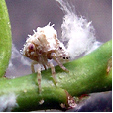
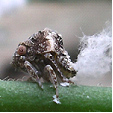
Appearance and Distribution of the Pest
This insect is found through the world and is primarily found on apple trees. It is first seen on the new woody growth where the bark is thin, buds or in wounds in the bark, forming colonies. Nymphs are distributed by wind or on clothing and infested plant material.
Life Cycle
This insect has a Hemimetabolous life cycle, ie. When the immature nymphs resemble the adults.
The species reproduces asexually; 2-20 live female nymphs are produced daily. Some sexual forms produce eggs, which seldom hatch. Many generations appear each year. The immature form overwinters on the roots or near the ground on the trunk of the host.
Period of Activity
During winter (and during periods of unusually high temperatures), most activity is below-ground, or in sheltering cracks in the lower trunks of host plants. Otherwise, the aphids are most active through Spring and Summer, especially during humid conditions.
Damage Caused
Larvae suck sap on lateral growth, shallow roots and trunks of apples, where the wood is thin or has been broken as a result of injury (including old feeding sites). Feeding sites may become gnarled and trunks & roots disfigured; buds are destroyed and the overall vigour of the plant is reduced with less new growth. Excreted honeydew produces sooty mould, to which the waxy threads adhere; this interferes with photosynthesis, weakening the plant. Heavy infestations cause fruit to fall prematurely.
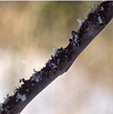
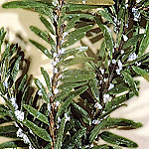
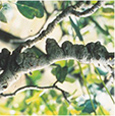
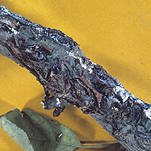
Susceptible Plants
Apple trees are the main host of this insect and are more susceptible when in poor health, this leads to low quality fruit and an overall loss of vigour. Ornamentals such as Crab-apples, Cotoneasters, Hawthorns are also attacked.
Cultural Control
It is very difficult to eradicate this pest but numbers can be kept down to a non-problem level. Infested parts may be removed; however, reinfestation is likely due to migration of larvae from infested roots. Note that some host species have resistant rootstocks and are preferred plantings. When mowing or wiper-snippering around susceptible plants take care not to damage the bark on the trunk. Bark eating animals such as cattle, sheep or wallabies should be kept away from the plants. Other preventive measures include pruning during summer when the wounds heal quickly and all wounds should be painted with a antifungal sealant.
Biological Control
Ladybirds, lacewing lava, syphid fly and parasitic wasps generally keep the aphid in check if the plants are not sprayed.
Chemical Control
Winter oil may reduce some over-wintering larvae populations. Insecticides, if used, will also destroy the parasitic wasp, which is an introduced and effective predator.
Note
Always read the label for registration details and direction of use prior to application of any chemicals.
PEST
NAME
Caterpillars (General)
Various species
Description of the Pest
There are many types of caterpillars from moths or butterflies, cutworms, bag moths, case moths, leaf rollers leaf skeletonises. The larvae generally eat leaves, seeds, flowers or buds by chewing out pieces. The size of the piece will depend on the size of the caterpillar and generally they are voracious eaters. The method of eating varies such as the leaf skeletoniser which leaves a network of veins or whole leaves are consumed.
The larvae have mainly 4 or 5 pairs of prolegs except Loopers which have 2 -3 pairs of prolegs. The number of prolegs can help in identifying the insect.
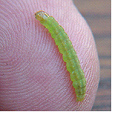 Small and Large Types
Small and Large Types 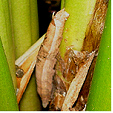
Casuarina Moth (Pernattia exposita) is gregarious, brown with a large head and tufts of hairs that line the slender body. It grows to 25 mm long and forms a tightly woven cocoon on the side of branchlets. The large female adult moth has a stocky body and generally slow moving, the male is smaller.
The larvae cause extensive damage to A. littoralis, A. stricta, C. cunninghamiana, C. glauca, and C. equisetifolia.
The hairy larva feed on the 'leaves" phyllodes, and stems, this can lead to ringbarking and death of branches.
Monitoring
Place sheets on the ground and disturb (shake) the tree for the larva drop to the ground on silken threads.
Spruce Budworm (Choristoneura fumiferana) is a reddish brown with a yellow stripe on its side and chews on the opening buds and the needles of the host. The adult moth is dull grey with brown bands and spots on the wings, appearing in early summer. The larva is very destructive in northern hemisphere coniferous forests.
Banksia Moth (Danima banksiae) is a caterpillar up to 60 mm long and is brown with black and white markings on its sides and when disturbed it arch backwards and reveal an extruded red underside, close to its head. The grey adult moth has an orange coloured body with a wing span that is up to 80mm across with black and white markings.
Banana moth (Opogona sacchari) is in the order Lepidoptera. This nocturnal moth as a wing span up to 25 mm wide and is bright yellowish brown with a dark brown spot on the wings. It has a life cycle that lasts approximately 3 months with the eggs hatching in 12 days and the whitish larva with a reddish brown head is up to, 26 mm long, and lives for 50 days at 15° C. In warmer climates life cycle is quicker with up to eight generations per season. The female moth uses a ovipositor to lay up to 500 eggs in groups of five amongst the crevices of the plant. The voracious larvae tunnel into the plant, avoiding light. In bananas it infests developing fruit and in ornamental plants it prefers the fleshy stems, particularly in cacti, begonias, African violets and is also a serious pest of Pritchardia and Chamaedorea species. Symptoms include tunnelling activity, which may be difficult to see then dead areas appear on the stems. As the caterpillars destroyed xylem tubes leaves begin to wilt and the plant may collapse and die. In European countries it is a glasshouse pest that is controlled chemically.
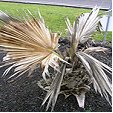 Pritchardi species
Pritchardi species 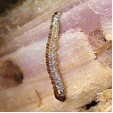 Banana moth larvae
Banana moth larvae
European Pine Shoot Moth (Rhyacionia buoliana) lays eggs on Pinus species during late spring on the new buds and the emerging caterpillars in late summer feed on the shoots causing them to fold and become deformed, eventually dieing. A major problem in the pine forests of the northern hemisphere
Large Grass Yellow Butterfly (Eurema hecabe) is a small attractive yellow butterfly. with a wing span of 40 mm that lays its eggs on the feathery leaves on Acacia species such as A. baileyana, (Cootamundra wattle), A. spectabilis (glory wattle). Other plant foods include Cassia spp, Caesalpinia spp, Senna spp. Albizia julibrissin (silk tree) A. paraserianthes (Albizia) sp Aeschynomene sp (Budda pea), Indigofera australis (Australian indigo's), Sesbania cannabina (yellow pea-bush), Senna surattensis (Glossy shower), Leucaena leucocephala (wild tamarind).
The small lava are up to 15mm long, green with white lateral bands and feed on the leaves at night in small groups, hiding under the leaves during the day. Large infestations may strip trees and require control. The larva of this insect does not feed on grasses. The adults are important pollinators of many Australian native plants. Various sub species of this insect are found through out Asia.
Gypsy Moth (Porthetria dispar) lava is a hairy grey caterpillar that is marked with blue and red dots along its back and can grow to 75mm long. It is capable of defoliating large trees and is a major problem for several species. A major problem in the northern hemisphere.
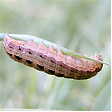 Lawn Armyworm
Lawn Armyworm
Lawn Armyworm (Spodoptera mauritia) is a plump, smooth caterpillar that is darkish brown to black with multiple stripes and pattens along its body. It can grow to 50mm long and tapers from the head. They are gregarious and move around in groups, like an army. If disturbed the larva drop to the ground and curl up, "faking death" The larva pupate in the soil. They are a pest of grasses and monocotyledon crops mainly.
This insect is also found throughout Asia.
Monitoring
Drench a known area with old fashion soap 2L / 1000 cm 2. Note the numbers of larvae emerging.
Oblique-banded Leaf Roller (Choristoneura roseceana) lava feeds on the leaves and forms a nest by drawing the leaf margins together using silk threads. The adult moth is up to 25mm across the wingspan and is reddish brown with three darker brown bands across the wings. This is a problem in the apple growing areas of North America. It feeds on Maples, hawthorns, crab apples, Blackberry (bramble) and raspberries.
Red Humped Caterpillar (Schizura concinna) is a lava has a red head and humps with yellow and black strips on the body. It grows from eggs that were laid on the underside of leaves by the adult greyish brown moth that has a wing span up to 30mm across.
Tailed Emperor Caterpillar (Polyura pyrrhus spp. sempronius) adult is a large butterfly with a wing span up to 110 mm with four long tapering tails and the rear of the wings. The fleshy caterpillar with four obvious backward facing horns on a shield shape head. It is dark green with yellowish bands and transversal stripes over its back and grows up to 80 mm in length.
It is commonly found solitary or in small groups. Found over much on mainland Australia. The adults are attracted to overripe fruits they become drunk on this and so are easy to capture. The larvae feed on many plants including, Acacia baileyana (Cootamundra Wattle, A. spectabilis (Glory wattle), Delonix regia (Poinciana), Cinnamomum camphora (Camphor laurel) Robinia pseudoacacia (Black or false locust) Lagerstroemia indica (Crepe Myrtle), Argyrodendron actinophyllum (Black booyong), Celtis spp (Hackberry), Brachychiton spp (Kurrajongs) Gleditsia triacanthos (Honey locust).
Verbena Moth (Crambodes talidiformis) lays its eggs on the outside of the plant and the small green caterpillar that attacks seed pods by entering and eating the contents. It half emerges while pupating appearing as a small brown bump circled by a black ring. Native to North America
White Tussock Moth (Hemerocampa leucostigma) produces lava that is up to 50mm long. It has a red head with a yellow body that is marked in black and has four tufts of hair. The caterpillars pupate on the branches and the eggs laid by the adult moth overwinter on the trunk and are covered in a white waxy material. They are found on Aesculus species. A pest in North America of Oaks.
Life Cycle
This insect has a Holometabolous life cycle, i.e. it has a larval and a pupal stage.
Distribution of the Pest
Many species are found throughout the world from tropical to temperate regions and most of the adults are capable of by flying
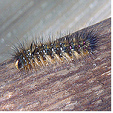 Many hairy caterpillars can be irritating
Many hairy caterpillars can be irritating 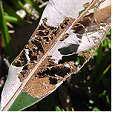 Leaf Skeletonised
Leaf Skeletonised
Period of Activity
Most active during the warmer months from spring to autumn.
.
Damage Caused
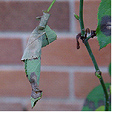 Leaf Rollers
Leaf Rollers
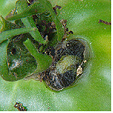 Caterpillar Inside a Tomato
Caterpillar Inside a Tomato
Susceptible Plants
A wide range of native and exotic plants are attacked and can be a major problem in commercial crops or turf grasses. Plants with soft-textured foliage (eg vegetables, some indoor plants) are preferred, but trees and shrubs are commonly attacked.
Malvaceae Abutilon spp, Hibiscus spp and other members of the family are attacked by the castor oil looper, Croton caterpillar (Achaea janata) which feed on leaves. The tip borer Cotton tipworm (Crocidosema plebejana), Rough bollworm (Earias huegeliana) which feeds on young stems, flowers and seeds. A leaf miner (Phyllonorycter spp)
Acer saccharinum and Fagus species are attacked in North America by the Maple Leafcutter (Paraclemensia acerifoliella) that forms a small cocoon in leaves that it skeletonises.
In Australia Case moths and Painted apple moths (Teia anartoides)
Ailanthus altissima is attacked by the Cynthia Moth (Samia cynthia) light green lava, which eats leaves and the Ailanthus Webworm (Atteva aurea) which are olive-brown caterpillars that form web nests in the leaves.
Antirrhinum species are attacked by the Leaf Tier (Udea rubigalis) lava. This caterpillar eats pieces out of leaves and binds them together forming a nest. It is more commonly found in glasshouse culture.
Berberis species may become infested with the Barberry Worm (Omphalocera dentosa). This small caterpillar is black with white spots, up to 14mm long and feeds on young shoots and leaves. It also binds the shoots with a silken thread to form a nest.
Betula species are attacked by the Leaf Skeletonizer (Bucculatrix canadensiella). The small adult moth has brown wings with a whitish underside and its yellow green, 7mm long lava skeletonise the undersides of the leaf turning it brown.
Brachychiton, Senna and feathery-leaved Acacia species are attacked by the Tailed Emperor Caterpillar, particularly in dryer periods.
Catalpa species are attacked Catalpa Sphinx (Ceratomia catalpae). This large yellow and black Caterpillar grows to 76mm long and attacks the leaves. Large infestations can completely stripped a tree and control is carried out by spraying.
Calendula and Canna species are attacked by the Woollybear Caterpillar (Diacrisia virginica) which has yellow and black lines down its body is up to 50mm long and eats the leaves or flower buds. In Canna species the chewed holes tend to be in a straight line across the leaf.
Celtis species are attacked by the Spiny Caterpillar (Nymphalis antiopa) which is reddish, up to 50mm long and feeds on the leaves at the top of branched in groups.
Cheiranthus species are attacked by the Diamond-backed Moth (Plutella maculipennis) lava, which is a small green caterpillar to 14mm long that feeds on the underside of leaves and may form a shot hole appearance. It forms a small cocoon to pupate in and in cooler climates it may be found in glasshouses.
Cotinus, Fraxinus, Betula, Cornus, Crataegus, Aesculus, Tilia, Acer, Quercus and Populus species are susceptible to attacked by the Oblique-banded Leaf Roller (Archips rosaceana)
Iris and Antirrhinum species are attacked by Verbena Moth.
Picea, Abies, Tsuga and Pinus species are attacked by Budworm commonly found in the northern hemisphere.
Populus and Carya species are attacked by the Red Humped Caterpillar which chews the leaves.
Quercus species are attacked by several caterpillars including Saddleback Caterpillar (Sibine stimulea) and Datana Caterpillar (Datana ministra) that feed on the leaves.
Samanea saman is attacked by several caterpillars (Ascalapha odorata, Polydesma indomita and Melipotis indomita). These caterpillars defoliate the tree but cause no long term problems.
Spiraea, Fraxinus, Betula, Cornus, Crateagus, Acer, Quercus and Populus species are attacked by the Oblique-banded Leaf Roller.
Ulmus, Salix, Crateagus, Tilia, Quercus and Populus species, Pseudotsuga menziesii are attacked by the Gypsy Moth (Porthetria dispar).
Ulmus species are attacked by the Spring Cankerworm (Paleacrita vernata), which chews the leaves during spring and the Fall Cankerworm (Alosphila pometaria), which also eats the leaves during autumn. Ulmus species are also attacked by several caterpillars including the lava of the Leopard Moth (Zeuzera pyrina) and the Tussock Moth (Hemerocampa leucostigma).
Cultural Control
Small numbers may be removed by hand and squashed while others species such as the Casuarina Caterpillar drop to the ground when disturbed by hitting with a stick or shaking the plant. On the ground they can be squashed or collected and placed in a bucket of soapy water. All rubbish around plants and glasshouses should be cleared as certain moths overwinter in such places.
Biological Control
There are many natural predators that reduce numbers including birds, lizards, frogs; other predators are wasps, viruses, and fungi.
Chemical Control
The small plant may be sprayed using Pyrethrum-based insecticide to reduce numbers or dusted with an equally environmental friendly chemical. In severe cases crops may be sprayed with Carbaryl.
Note
Always read the label for registration details and direction of use prior to application of any chemicals.
PEST
NAME
Oak Leafminer
Phyllonorycter messaniella
ORDER
Lepidoptera
FAMILY
Gracillariidae
Description of the Pest
The adult is a very small moth; the cream-coloured larvae are up to 5mm in length and have chewing mouth parts.
Appearance and Distribution of the Pest
This is an European native insect and is found commonly throughout Australia.
Life Cycle
This insect has a Holometabolous life cycle, ie. When metamorphosis is observed during the pupal stage.
Period of Activity
Most active in cool to mild temperate climates.
Damage Caused
Larvae burrow into the underside of leaves, where the eggs were laid, causing blistering, which appears on the upper surfaces as pale blotches. The damaged leaves become brown and papery, resulting in a burnt appearance and leaf loss.
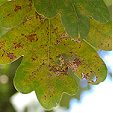
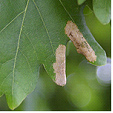
Susceptible Plants
Favoured plants include oak, chestnut, beech, apples, liquidambar, stonefruit, and apples.
Cultural Control
Removal and destruction of fallen leaves is a preventative measure to reduce numbers in the subsequent season.
Biological Control
None known.
Chemical Control
During early infestations, when larvae are active, systemic pesticides may be effective.
Note
Always read the label for registration details and direction of use prior to application of any chemicals.
DISEASE
NAME
Coral Spot
Nectria cinnabarina
Description
A casual fungal problem that attacks broad-leafed shrubs and trees.
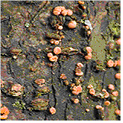
Symptoms
The fungus causes the twigs and branches to die back followed by rounded pustules that are pink to coral red producing spores. The branches become brittle and in extreme cases the plant dies.
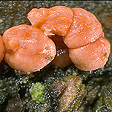
Source and Dispersal
The fungus is derived from other infected plants and the spores are dispersed by wind. Infection occurs by entering the plant through wounds, normally the result of poor pruning techniques or wind damage.
Favoured Conditions
There are no current references to favoured conditions but generally fungal attack occurs during humid weather.
Affected Plants
A wide range of ornamental trees and shrubs are infected including Acer, Cercis , Morus, Juglans, Eleagnus and Magnolia species.
Non-chemical Control
Cut back and destroy infected branches and remove heavily affected plants. Use sharp tools when pruning, avoiding snagging the wood and use disinfectant on the blades between plants.
Chemical Control
There is no satisfactory chemical control.
Note
Always read the label for registration details and direction of use prior to application of any chemicals.
DISEASE
NAME
Canker (General)
Various Canker Species
Description
This is a fungal problem that enters the plant through wounds causing dieback of twigs and stems.
Symptoms
The stems become discoloured (pale brown) usually from a pruned point, working its way down the stem and normally intersecting or surrounded with live cambium. The bark splits or cracks, foliage dies and infected areas can develop tiny black fruiting bodies. Heavy infected plants eventually die, though certain varieties are resistant halting the spread of the infection.
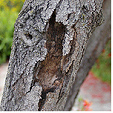
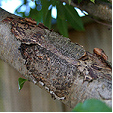
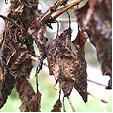
Black Canker (Phyaslospora miyabeana) forms dark brown spots with concentric rings on the upper leaf surface and grey spots on the stems. The tiny black fruiting bodies develop in the stem lesions. It is found on Salix species and persistent attacks will kill the tree.
The Canker (Cytospora valsa) causes the browning and death of branches in Picea abies and Picea pungens. This infection occurs normally from the base of the tree with infected needles falling, and white resinous patches appearing on the bark accompanied by cankers with tiny black fruiting bodies.
The Canker (Corynneum cardinale) is a casual fungus that invades wounds and infects living bark and associated cambium turning the foliage yellowish. As it spreads it girdles the branch killing it and ultimately the top of the tree dies out. Cankers eventually form in the trunk and ooze resin. It is found on Cypress.
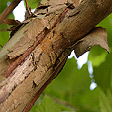 Platanus x hybrida
Platanus x hybrida
Cankerstain (Ceratocystis fimbriata f. platani) forms sunken cankers on the trunk and large limbs forming longitudinal cracks and roughened bark. Infected areas form callus around the margins which dies off and when cut open, dark coloured streaks are revealed extending to the central pith. These streaks then radiate out into uninfected wood resulting in the thinning of the crown and producing unusual small leaves. It is normally transmitted through poor tree surgery techniques and infected tools.
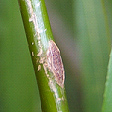 Cytospora Canker
Cytospora Canker
Cytospora Canker (Cytospora chrysosperma) is a casual fungus that infects the young twigs, then moving to the stems, branches and trunk causing brown sunken areas to appear that is covered in red pustules. The fungus tends to attack trees that are in poor health. Control requires the removal of infected branches and improved culture to regain the plants vigour. Sorbus aucuparia, Salix and Popular species are susceptible.
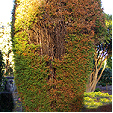 Cypress Canker
Cypress Canker
Cypress Canker (Seiridium species) enters the plant through wounds or through insect damage causes the bark to spread revealing brown powdery spores that are accompanied by oozing resin. The canker eventually girdles the branch or trunk causing ringbarking and the death of the plant.
Nectria Canker (Nectria Cinnabarina) forms cankers on the twigs and small branches producing red fruiting bodies and eventually killing the tree. It is found in many parts of the world infecting a range of trees including hardwoods.
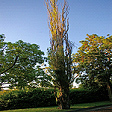
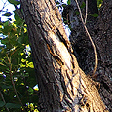
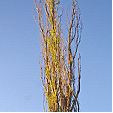 Populus nigra
Populus nigra
Poplar Canker (Cryptodiaporthe populea) infects the cambium layer damaging the bark and sapwood where the elongated sunken canker forms. Branches are girdled causing the upper portion to die off. This is a serious problem for Populus nigra var. Italica entering the plant through wounds or the leaves then spreading to twigs and branches. Control is difficult as removal of infected parts will not eradicate the problem, but encourage it. Young plants may be sprayed with a copper based fungicide to reduce leaf infection and heavily infected plants should be removed the burnt.
Stem Canker of Red Flowering Gum (Sporotrichum destructor) enters through wounds in the bark forming cankers in the trunk and branches, splitting the bark apart, revealing the wood and infesting the surface with powdery spores. This infection causes the leaves to wither and then the branches die, eventually killing the tree.
Stem Canker (Strumella coryneoidea) is a casual fungus that forms on the trunks of trees as a smooth, dispersed or sunken infection. On mature trees the infection sheds the bark with the canker forming callus tissue around the margins and the centre being exposed. These cankers then tend to extend up and down the trunk, only girdling over a long period of time. It is found on Quercus, Fagus, Aesculus species, and Acer rubrum , Nyssa sylvatica, Carya ovata and Morinda citrifolia.
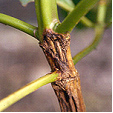
Source and Dispersal
The spores are found on infected dead plant material and can be dispersed by wind and with splashing water.
Favoured Conditions
It prefers a warm humid conditions and plants that have a wounds derived from poor pruning techniques and insect or other damage, especially if water is allowed to settle on the wound.
Affected Plants
Cankers may infect a wide range of trees and shrubs with some species being specific to its host. Examples are listed below.
Abies species are infected by several cankers including (Cytospora pinastri), (Cryptosporium macrospermum) and (Scoleconectria balsamea). These fungi form dead sunken areas on the trunk and branches.
Alnus species are infected by a few cankers including (Nectria coccinea) and (Physalospora obtusa) these attack the branches causing die back.
Betula species may be infected by the Canker (Nectria galligena) that occurs in the forks of trees causing splitting and cracking of the bark by swelling, to reveal the canker. Callus rings may form around the affected areas as a defence mechanism triggered by the tree.
Buxus species are infected by the Canker (Pseudonectria rousseliana) which shows signs of poor new growth during spring with the leaves turning from light green to a tan colour. These leaves tend to lay flat along the stems and reddish pustules appear both on the stems and leaves. The bark becomes loose and on inspection reveals a darkish colour underneath. It is difficult to control and the canker can kill the plant.
Castanea species are infected by the Twig Canker (Cryptodiaporthe castanea), a fungal problem that causes significant damage to the twigs and small branches, but tends to attack stressed trees.
Cercis and Ribes species are infected by the Canker (Botryosphaeria ribis) which forms small sunken areas on the stems causing wilting and eventually killing the branch by girdling. The cankers turn the bark black then split it open and the adjoining wood becomes discoloured. This is a serious problem for this and many other plant species.
Cotoneaster, Betula, Catalpa and Aesculus species are infected by the canker (Physalospora obtusa).
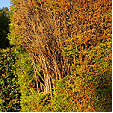
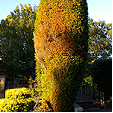 Cypress Canker
Cypress Canker
Cupressus species and Chamaecyparis lawsoniana are susceptible to Cypress Canker (Seiridium species) which causes leaf browning and then girdles the trunks resulting in ringbark. There is also another Canker (Coryneum cardinale) that has simular characteristics and is found in the northern hemisphere.
Cupressus sempervirens is infected by Cytospora Canker (Cytospora cenisia var. littoralis).
Larix species are susceptible to several fungal cankers including (Trichoscyphella wilkommii), (Trichoscyphella ellisiana), (Aleurodiscus amorphus), (Leucostoma Kunzei) and (Phomopsis spp.)
Nyssa sylvatica is attacked by three cankers including (Strumella coryneoidea).
Pinus species are infected by many types of cankers.
Platanus species are infected by Cankerstain.
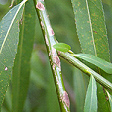 Cytospora Canker on Salix babylonica
Cytospora Canker on Salix babylonica
Pseudotsuga menziesii Douglas Fir is attacked by several cankers including (Cytospora species), (Dasyscypha ellisiana), (Dasyscypha pseudotsugae), (Phacidiopycnis pseudotsugae) and (Phomopsis lokoyae). These infections normally do not require control and are more prevalent on the coastal form.
Salix and Populus species are infected by several cankers including Cytospora Canker (Cytospora chrysosperma), Hypoxylon Canker (Hypoxylon pruinatum), Septoria Canker (Mycosphaerella populorum) and Branch Gall (Macrophoma tumefaciens). Many of these fungi can cause the death of the plant.
Thuja orientalis, Cupressus and Juniperus species are infected by the canker (Corynneum cardinale).
Tilia and Acer species are infected by (Nectria cinnabarina) attacking twigs or branches.
Tsuga species are infected by several cankers including (Dermatea balsamea) and ( Cytospora species).
Ulmus species are infected with up to eight fungal cankers including (Apioporthe apiospora) and (Nectria coccinea).
Vaccinium ovatum is infected by the canker (Coryneum microstictum) which attacks the stems.
Vinca species are infected by canker-dieback (Phomopsis livella) causing the shoots to wilt, turn brown and die. This can reduce the plant to ground level, and normally occurs during rainy periods.
Non-chemical Control
It is very difficult to control and correct pruning techniques with sharp tools for repairing wounds or prune well below the infected areas. Ensure that there are no ragged edges on the cuts and the angle should cut allows water to run off or dress the wound. Plant resistant varieties when available. Heavily infected trees should be removed to avoid spreading the disease.
Improve the culture of the affected plant to increase vigour for greater resistance.
Chemical Control
There is no satisfactory chemical control and prevention is imperative.
Note
Always read the label for registration details and direction of use prior to application of any chemicals.
DISEASE
NAME
Lichens
Various Lichen Species
Description
A fungus and an alga growing in a symbiotic relationship. The food producing alga is given support and shelter by the fungus.
Symptoms
Lichens are variable, occurring in many shapes, sizes and colours from flat to circular and may be leaf like crinkly or hairy. The colour also varies from greenish grey to yellow or orange. They occur on many surfaces including tree trunks, rocks, fences and roof tiles. They cause little harm to living plants and certain types are attractive while others are unsightly.
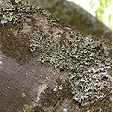 Fagus sylvatica
Fagus sylvatica 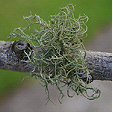
Source and Dispersal
Contaminated areas, and is dispersed by wind or splashing water.
Favoured Conditions
Conditions are variable as some types prefer cool moist situations while others tolerate open exposed positions.
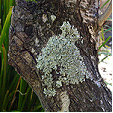
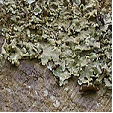
Affected Plants
There are many plants that form lichens on the bark, particular old woody trees that are in shaded moist positions. Shrubs and Palms also form coverage of lichens on there stems under moist conditions.
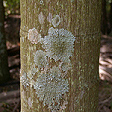 Archontophoenix cunninghamiana
Archontophoenix cunninghamiana 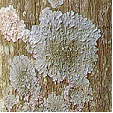
Non-chemical Control
Under normal circumstances, unnecessary but lichens can be removed by scraping or scrubbing.
Chemical Control
Not normally required but lichens can be killed by spraying the fungicide copper oxychloride but take care as the chemical may damage certain building materials.
Note
Always read the label for registration details and direction of use prior to application of any chemicals.
DISEASE
NAME
Powdery Mildew
Various Powdery Mildew Species
Description
Powdery mildew covers arrange of fungal infections most with simular characteristics of white powdery areas appearing on the leaves and flowers.
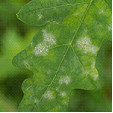
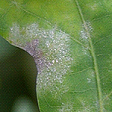 White powdery area
White powdery area 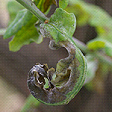
Symptoms
Powdery mildew (Oidium species) affects the following five plant groups with slightly different characteristics.
Cucurbits firstly form white spots on the underside of the leaves. Under optimum conditions the fungus spreads to the upper surface covering the entire leaf causing it to die. It may also extend to the stems slowing the growth of the plant and may reduce the size of the fruit.
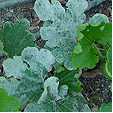
Grape leaves, flowers and fruit are attacked with the appearance of greyish-white powdery spots. Infected flowers set poor quality fruit and infected fruit splits open and dries out.
Pawpaw leaves become infected on the underside at first then spreading covering the entire leaf. The fruit forms irregular light grey spotted areas that damages the surface and under the surface causing the fruit to misshapen and reducing its market value.
Rose leaf and buds are covered in a fine white powdery coating and in severe cases it extends to the stems. When young leaves are infected they become distorted and older leaves develop blackened areas. Infected flower buds may fail to open and opened blooms may be discoloured or distorted.
Strawberries show different signs of infection with the leaf margins first rolling upwards then developing purplish irregular blotches along the veins. The infected flowers may fail to set fruit and if fruit is produced it is small, hard fails to ripen. Semi mature fruit that is infected has dull appearance and may form cracks or split open.
The Powdery Mildew (Sphaerotheca lanestris) infects leaves and twigs. The under side if the leaf firstly has a white mealy growth that matures to felt-like brown mycelium that can cover the entire leaf, and the twig tips. It is only one of the many types that infect Quercus species.
Source and Dispersal
The spores overwinter in fallen leaves, dormant buds, seed and infested plants. It is dispersed by wind.
Favoured Conditions
Generally it prefers warm humid conditions, but failing to germinate when it is raining. The fungus that attacks Pawpaw prefers cooler conditions disappearing in the warmer months.
Affected Plants
There are many plant species ornamental trees and shrubs that are attacked by Oidium species including; Roses, African Violets, Cucurbits, Grapes, Pawpaw, Strawberries, Hydrangeas, Ajugas, Antirrhinum, Oaks and Photinias.
Acer species are infected by the powdery mildews (Uncinula circinata) and (Phyllactinia corylea) but are not normally serious.
Aesculus species are infected by the powdery mildew (Uncinula flexuosa) which forms a white mold on the underside of the leaves.
Arenaria,Cuphea, Erica and Eschscholtzia species are infected by the powdery mildew (Erysiphe polygoni). This fungus is greyish or white and covers leaves or young shoots. Heavenly infected leaves turn brown and fall from the plant. The plant eventually dies.
Aster species are infected with the powdery mildew (Erysiphe cichoracearum) which is more prevalent on the lower part of the plant.
Ceanothus, Corylus, Platanus, Syringa and Weigela species are infected by the powdery mildew (Microsphaera alni) particularly London Plane. The mycelium forms a felt-like cover on the leaves.
Celtis species are susceptible to the powdery mildew (Uncinula parvula) and (Uncinula polychaete). This fungal problem can affect either side of the leaf, which can have spots or be completely coved in mildew. The fruiting bodies appear on the opposite side of the mildew.
Cornus species leaves are infected by the powdery mildew (Microsphaera alni) and (Phyllactinia corylea), covering the leaves in a whitish fungus.
Dahlia species are infected by the powdery mildew (Erysiphe cichoracearum) that forms white powdery areas on the leaf surface.
Lagerstroemia species are infected by the powdery mildew (Uncinula Australiana) that forms white powdery growth on the leaves and may also distort the infected foliage.
Populus and Salix species are infected by a white powdery mildew (Uncinula salicis) that produces black fruiting bodies with a curled tip, but is not normally a major problem.
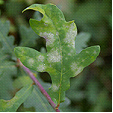
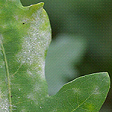 Quercus robur
Quercus robur
Quercus species are susceptible to several powdery mildew fungi including (Sphaerotheca lanestris), (Erysiph trina) and (Phyllactinia corylea). Generally white mealy growth appears on the leaves, normally on the underside turning the infected areas brown and then the leaf dies. The infection may spread to the twig tips causing dieback. Control may be difficult and unwarranted on large trees but nursery stock may be sprayed with a fungicide during susceptible periods.
Rosa species are also infected by the powdery mildew (Sphaerotheca pannosa).
Rudbeckia and Senecio species are covered in white fungus (Erysiphe cichoracearum) which infects leaves, flowers and stems. This results in the plant becoming stunted.
Senecio species are infected by the powdery mildew (Sphaerotheca fuliginea) which forms circular white powdery areas on the leaves.
Spiraea species are infected by the Powdery Mildew (Microsphaera alni) and (Podosphaera oxyacanthae).
Ulmus and Rhododendron (Azalea) species are also infected by (Microsphaera alni). Circular patches of white powdery growth appear on the leaves.
Veronica species are sometimes infected by the powdery mildew (Sphaerotheca humili) causing a white coating to appear on the leaves. Not normally a major problem.
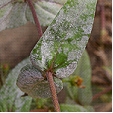
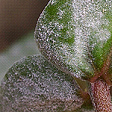
Zinnia elegans are commonly infected by the powdery mildew (Erysiphe cichororacearum), which appears on both sides of the leaves as a greyish powdery cover and may be transmitted by seed.
Non-chemical Control
Choose less susceptible species and when planting space the plants to allow good air circulation. Avoid overwatering and try to keep the foliage dry. Affected plants may be dusted with powdered sulphur or sprayed with a milk mixture to discourage mildew. Vegetables that are infected with mildew should be removed and replaced with new young plants, as they are more resistant to infection.
Chemical Control
Prenatitive spraying during warm humid conditions using a suitable fungicide such as wettable sulphur, bitertanol, carbendazim, fenarimol and triforine helps control the problem.
Note
Always read the label for registration details and direction of use prior to application of any chemicals.
Average Lowest Temperature : -10º C 14º F
USDA : 5, 6, 7, 8, 9
This USDA (United States Department of Agriculture) hardiness zone chart can be used to indicate a plant’s ability to withstand average minimum temperatures. However, other factors such as soil type, pH, and moisture, drainage, humidity and exposure to sun and wind will also have a direct effect on your plant’s survival. Use this chart only as a guide, always keep the other factors in mind when deciding where, when and what to plant.
A plant's individual USDA zone can be found in the Plant Overview.
Climate Description
Cool to Cold
These zones have low winter temperatures with moderate humidity and moderate summer temperatures.
Frosts and snow are severe. Droughts rarely occur and wind is cold.
Plant growth
Endemic native and exotic cool climate plants grow well within these zones.
| Dictionary | Growth Habit |
| Leaf Type | Botanic Flower Description |
| Leaf Shape | Flower Inflorescence |
| Leaf Arrangement | Fruit Type |
| Leaf Margin | Bark Type |
| Leaf Apex And Bases | Flower Description |